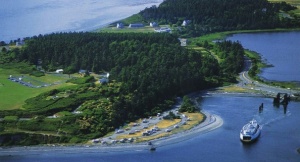Fort Casey (1): Difference between revisions
John Stanton (talk | contribs) No edit summary |
John Stanton (talk | contribs) No edit summary |
||
| Line 4: | Line 4: | ||
{{Clr}} | {{Clr}} | ||
'''Fort Casey (1900-1950)''' - In 1890 the Army established its garrison at Fort Casey named in honor of Brigadier General [[Thomas Lincoln Casey]], the last U.S. Army chief of engineers. A small detail of troops arrived on the reservation shortly after the completion of the gun emplacement. the first garrison numbered thirty men under the command of Lieutenant A.D.Putnam. Fort Casey was officially activated about 1900 and although it's guns were never fired in anger, it remained an integral part of the US defense. Fort Casey, with [[Fort Worden]] and [[Fort Flagler]], comprised a "triangle of fire" guarding the entrance to Puget Sound. All the guns were removed from Fort Casey prior to it's abandonment by the US Army in 1950. | '''Fort Casey (1900-1950)''' - In 1890 the Army established its garrison at Fort Casey named in honor of Brigadier General [[Thomas Lincoln Casey]], the last U.S. Army chief of engineers. A small detail of troops arrived on the reservation shortly after the completion of the gun emplacement. the first garrison numbered thirty men under the command of Lieutenant A.D.Putnam. Fort Casey was officially activated about 1900 and although it's guns were never fired in anger, it remained an integral part of the US defense. Fort Casey, with [[Fort Worden]] and [[Fort Flagler]], comprised a "triangle of fire" guarding the entrance to Puget Sound. All the guns were removed from Fort Casey prior to it's abandonment by the US Army in 1950. | ||
{ | {|border="1" | ||
|+'''Fort Flagler Batteries''' | |||
|-style="background:LemonChiffon" | |||
!Endicott Period | |||
|-valign="top" | |||
| | |||
* Worth 2 10" 1898-1942 | |||
* Schenck 8 12" 1899-1942 | |||
* Seymour 8 12" 1899-1942 | |||
* Turman 2 5" 1901-1918 | |||
* Kingsbury 2 10" 1902-1942 | |||
* Moore 3 10" 1904-1942 | |||
* Parker 2 6" 1905-1918 | |||
* Trevor 2 3" 1905-1933 | |||
* Van Horne 2 3" 1905-1945 | |||
* Valleau 4 6" 1907-1918 | |||
|} | |||
---- | ---- | ||
{| | {| | ||
| Line 39: | Line 55: | ||
[[Category:Washington All]] | [[Category:Washington All]] | ||
[[Category:Washington Forts]] | [[Category:Washington Forts]] | ||
[[Category:Coastal Forts]] | |||
[[Category:Endicott Period Forts]] | |||
[[Category:Restored]] | [[Category:Restored]] | ||
[[Category:Preserved]] | [[Category:Preserved]] | ||
[[Category:State Park]] | [[Category:State Park]] | ||
[[Category:{{PAGENAME}}]] | [[Category:{{PAGENAME}}]] | ||
Revision as of 19:12, 22 January 2008

Fort Casey (1900-1950) - In 1890 the Army established its garrison at Fort Casey named in honor of Brigadier General Thomas Lincoln Casey, the last U.S. Army chief of engineers. A small detail of troops arrived on the reservation shortly after the completion of the gun emplacement. the first garrison numbered thirty men under the command of Lieutenant A.D.Putnam. Fort Casey was officially activated about 1900 and although it's guns were never fired in anger, it remained an integral part of the US defense. Fort Casey, with Fort Worden and Fort Flagler, comprised a "triangle of fire" guarding the entrance to Puget Sound. All the guns were removed from Fort Casey prior to it's abandonment by the US Army in 1950.
| Endicott Period |
|---|
|
|
{"selectable":false,"width":"500"} |
Location: Maps & Images Lat: 48.16241 Long: -122.67995 |
Sources:
- Hart, Herbert M., Tour Guide to Old Western Forts, Pruett Publishing Co., Boulder CO, 1980, ISBN 0-87108-568-2, page 181
Links:
Publications:
Visited: No
Picture Gallery
|
Click on the picture to see a larger version. Contribute additional pictures - the more the better! |